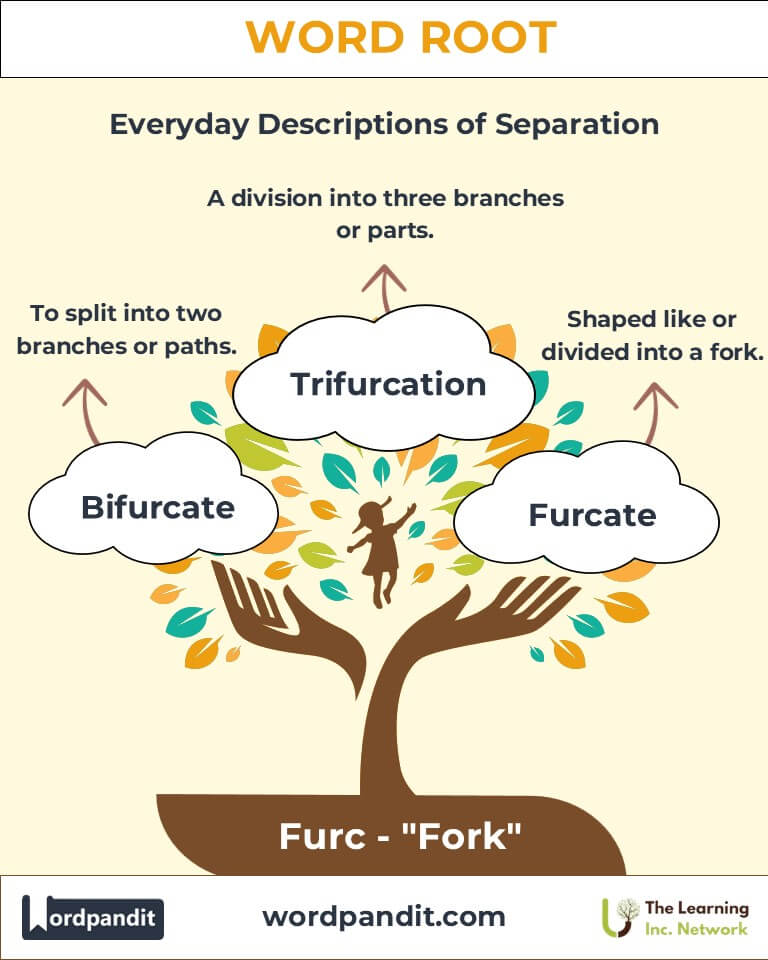Furc: The Linguistic Fork in the Road
By delving into the meaning and impact of the word root "Furc," we uncover its origins, diverse applications, and enduring relevance in modern vocabulary. This article explores how "Furc," meaning "fork," shapes language and conveys the concept of branching paths in various disciplines.

Table of Contents
- Introduction: Furc - The Linguistic Fork in the Road
- Etymology and Historical Journey
- Mnemonic: Unlocking the Power of Furc
- Common Furc-Related Terms
- Furc Through Time
- Furc in Specialized Fields
- Illustrative Story: Furc in Action
- Cultural Significance of the Furc Root
- The Furc Family Tree
- FAQs About the Furc Root
- Test Your Knowledge: Furc Mastery Quiz
- Conclusion: The Living Legacy of Furc
Introduction: Furc - The Linguistic Fork in the Road
Do you remember the last time you encountered a fork in the road—literally or figuratively? The word root furc (pronounced "furk") encapsulates this idea. Originating from Latin, it means "fork," symbolizing division, choice, or branching. In biology, language, and everyday life, furc provides the foundation for words that describe branching structures, decisions, and pathways.

Etymology and Historical Journey
The root "Furc" traces back to the Latin word furca, meaning "fork" or "yoke." Ancient Romans used furca to describe a two-pronged agricultural tool or the branching of roads. Over centuries, the concept evolved, representing division or bifurcation in various contexts, from anatomy to philosophy.
Medieval scholars adapted the root into scientific terminology, associating it with natural forms like branches and antlers. This expansion laid the groundwork for its enduring use in multiple disciplines.
Mnemonic: Unlocking the Power of Furc
To remember "Furc," imagine a road splitting into two distinct paths, each leading to a different destination. This imagery mirrors the essence of "Furc" as a representation of branching or dividing.
Mnemonic Device: "Furc reminds me of forks in the road—where choices branch out like tree limbs."
Common Furc-Related Terms
- Bifurcate (pronounced bye-fur-kayt):
- Meaning: To split into two branches or paths.
- Example: "The river bifurcates into two smaller streams just beyond the ridge."
- Furcate (pronounced fur-kayt):
- Meaning: Shaped like or divided into a fork.
- Example: "The deer’s furcate antlers gleamed in the sunlight."
- Trifurcation (pronounced try-fur-kay-shun):
- Meaning: A division into three branches or parts.
- Example: "The trifurcation of the mountain trail puzzled the hikers."
- Quadrifurcated (pronounced kwod-ruh-fur-kayt-ed):
- Meaning: Divided into four branches.
- Example: "The quadrifurcated wiring system ensured efficient energy distribution."
- Furculum (pronounced fur-kuh-lum):
- Meaning: A forked bone found in birds, commonly called the wishbone.
- Example: "The furculum plays a critical role in avian flight mechanics."
Furc Through Time
- Bifurcate:
- Ancient Usage: Initially used to describe forks in rivers or roads.
- Modern Evolution: Now widely applied in decision-making scenarios, such as "bifurcating solutions" in logic or algorithms.
- Furculum:
- Historical Role: In early zoology, it was studied as a skeletal feature of birds.
- Present Use: The furculum remains a focus in evolutionary biology, connecting birds to their dinosaur ancestors.
Furc in Specialized Fields
Anatomy and Biology: The bifurcation of the trachea into bronchi is vital for respiratory function.
Mathematics: Bifurcation theory studies how systems split into distinct behaviors, critical in chaos theory.
Engineering: Engineers design bifurcated pipelines for efficient fluid distribution in industrial systems.
Law: Legal systems often use "bifurcation" to describe separating trials or cases into distinct phases.
Botany: Describes plant stems that fork, providing insights into growth patterns and ecological strategies.
Illustrative Story: Furc in Action
Dr. Lina Yates, a botanist, was tasked with solving the mystery of a rare plant species’ unique branching pattern. Using her knowledge of bifurcation in plant anatomy, she traced the species to a specific biome where nutrient scarcity caused trifurcation instead of the typical bifurcation in stem growth. Her discovery not only solved the mystery but also helped conservationists identify critical habitats to protect.
Cultural Significance of the Furc Root
In ancient Rome, crossroads symbolized choices and destiny, tying the furc root to profound cultural meanings. Today, phrases like "fork in the road" resonate universally, reflecting life's pivotal decisions. Such metaphors highlight the root’s enduring relevance in storytelling and philosophy.

The Furc Family Tree
- Brach (from Greek brachion, meaning "arm"):
- Example: Brachiate (to swing by the arms) or brachial (relating to the arm).
- Cruc (from Latin crux, meaning "cross"):
- Example: Crucial (decisive) or crucifix (a representation of a cross).
- Dich (from Greek dicha, meaning "in two"):
- Example: Dichotomy (a division into two contrasting parts).
FAQs About the Furc Root
Q: What does the word root "Furc" mean?
A: The root "Furc" originates from the Latin word furca, which means "fork." It is used to describe anything that branches, splits, or forks, whether literally, like a tree branch, or figuratively, like a decision point.
Q: What is bifurcation, and where is it commonly seen?
A: Bifurcation refers to the splitting of something into two branches or parts. It is widely seen in natural systems like rivers dividing into tributaries, anatomical structures like blood vessels, and decision-making processes where two options arise.
Q: How does "Furc" appear in biology?
A: In biology, "Furc" describes structures that fork or branch, such as the bifurcation of the trachea into bronchi. It also applies to natural phenomena like branching veins in leaves or tree roots.
Q: What is the furculum in birds, and why is it significant?
A: The furculum, or wishbone, is a forked bone in birds that supports their flight. It acts as a spring during wing flapping, helping with energy transfer and efficiency, and serves as a key feature distinguishing birds from their evolutionary ancestors.
Test Your Knowledge: Furc Mastery Quiz
1. What does "bifurcate" mean?
2. Which term refers to a bone in birds?
3. In chaos theory, bifurcation theory studies:
4. Trifurcation means:
Conclusion: The Living Legacy of Furc
The root Furc embodies the idea of branching and choice, resonating across disciplines from biology to philosophy. Its enduring relevance reflects humanity’s fascination with division and connection. As science advances, the linguistic fork in the road will continue to inspire both discovery and dialogue, shaping the way we think about the natural and conceptual worlds.












